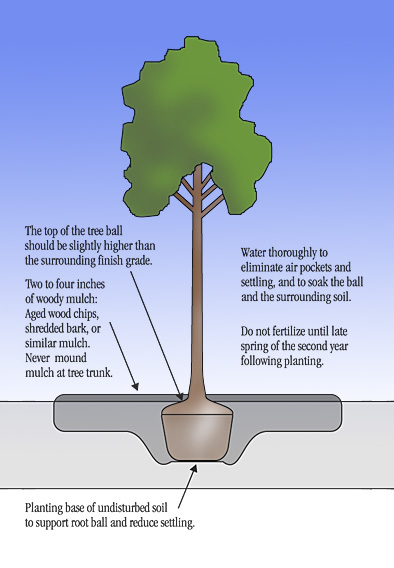Digging the Hole
The hole should be dug as large as practical, but at least twice the width of the root ball. If the soil is very dense and hard, the hole should be three to five times the width of the root ball. The hole should not be dug too deep.
 The hole should be slightly shallow so the top of the root ball is one to two inches above the level of the surrounding soil. The bottom of the hole should not be filled with soft soil or gravel to support and raise the tree.
The hole should be slightly shallow so the top of the root ball is one to two inches above the level of the surrounding soil. The bottom of the hole should not be filled with soft soil or gravel to support and raise the tree.
Removing the tree from the container
Before planting, the tree must be carefully removed from the container. In many instances, the tree will have been kept in the container for an extended period of time causing the roots to grow into a dense, circling mass packed into the container.
In these instances, the root mass should be sliced vertically around the root ball, in three to four places with a sharp knife, to allow you to separate the roots and cause them to grow out.
Roots that grow across and around the ball will not provide adequate support for the tree and will eventually girdle and strangle the tree.
Setting the tree
Use care when handling the tree to minimize damage to the tiny fibrous roots and the stem. Handle the tree by the root ball, not grabbing the trunk or branches. After the tree is set in the hole, check the height of the root ball to ensure that is not too low. Remove tags and labels so they do not girdle the tree.
Backfilling the hole
In most cases, it is better to backfill the hole with soil on the site. Research has shown that soil amendments do not assist in tree establishment and growth. Do not fertilize the tree until at least one growing season after planting.
Work the soil around the ball and firm it in to ensure that no air pockets are present. Do not pack the soil! Water thoroughly while backfilling to help eliminate air pockets. Ensure that the top of the root ball is slightly above the level of the surrounding soil. Do not plant the tree too deep!
It may be beneficial to create a small berm (mound of soil) around the perimeter of the hole to retain water. If the soil is very dense, leave some breaks in the berm so that excess water can drain.
When to Stake Your Tree
Do not stake trees unless absolutely necessary to support or to protect the tree from damage.
If staking is required, place one to three stakes to provide the desired support or protection. Support the tree by using soft flexible material, such as strips of rubber inner tube, that will not damage the tree bark from rubbing. If wire is used, cushion the wire where it contacts the tree by running it through a piece of rubber hose. Connect the supports high enough to support the tree without the tree bending above the tie point. Allow some flexibility in the supports to prevent bark damage, breakage of the supports, and to encourage development of a strong root system. Periodically, check the supports to ensure that they are not damaging the tree. Remove all supports after one growing season.
